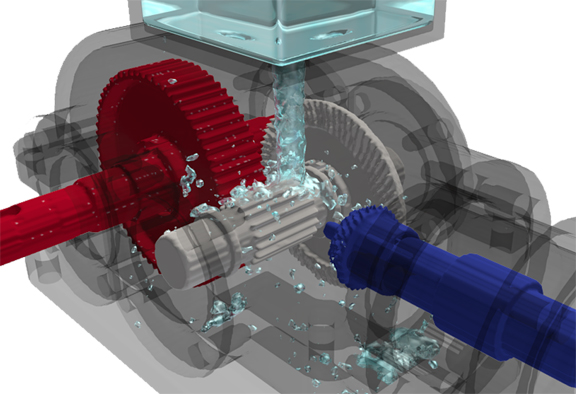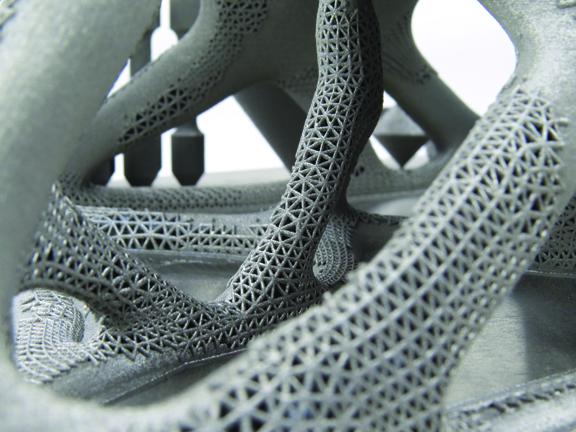
This month, Altair releases HyperWorks 14.0. Shown here is a drop test simulated in RADDIOSS solver (image courtesy of Altair).
Latest News
March 15, 2016
 This month, Altair releases HyperWorks 14.0. Shown here is a drop test simulated in RADDIOSS solver (image courtesy of Altair).
This month, Altair releases HyperWorks 14.0. Shown here is a drop test simulated in RADDIOSS solver (image courtesy of Altair).This month, Altair released Version 14.0 of its flagship engineering software suite HyperWorks. Simone Bonino, the company’s VP of marketing, introduced the new version to the industry press in a webcast. HyperWorks 14.0 features, among other things, a stronger graphics engine to deal with large finite element analysis (FEA) models, better scaling on HPC clusters, and new applications for system modeling.
The ever-increasing complexity of simulation jobs, usually quantified as the number of elements in the model, is a headache for manufacturers who rely on computer-aided engineering (CAE) software. So Altair took steps to address it by bolstering the software’s underlying graphics engine. On a high-end graphics engine, HyperWorks 14.0 is 15 times faster than HyperWorks 13.0 in managing a FEA model with 8.5 million nodes, 17 million elements, according to a chart shared by Bonino during the webcast.
 FluidDyna is GPU-accelerated in HyperWorks 14.0 (image courtesy of Altair).
FluidDyna is GPU-accelerated in HyperWorks 14.0 (image courtesy of Altair).GPU-Accelerated FluidDyna
The company has also made investments to ensure its FluiDyna product benefits from GPU acceleration. Now, both nanoFluid X, the product for particle-based fluid dynamics simulation, and ultraFluid X, the product for external aerodynamics simulation, are GPU-accelerated. Both are integrated into HyperWorks 14.0.
In a scalability test conducted with HPC system provider Cray, HyperWorks running a model with 15 million elements scale successfully on 8,000 CPU cores. It can be scaled up to as many as 16,000 cores, Bonino said.
Performance on hundreds or thousands of computing cores ensures that HyperWorks users can benefit from deploying the software on HPC clusters to speed up large-scale simulation jobs. Altair also offers HPC appliance, dubbed HyperWorks Unlimited; therefore, it has a vested interest to promote the use of its software on HPC systems.
New Node-Based Licensing
Bonino remarked, “Our licensing model has to adapt to the new HPC resources that are becoming available. In HyperWorks 14, we introduced solver-node license, which is an alternative to job-based licensing. It enables design exploring.” He pointed out that, with node-based licensing, “the number of HyperWorks Units required [for payment] decreases dramatically. That means you can run a lot more parallel jobs that enable design exploration.”
Design exploration or design of experiments (DOE) usually involves simultaneous analysis of many design variants for comparison. Because DOE is computation intensive, it’s usually performed on HPC systems equipped with hundreds or thousands of cores.
Polynurbs in solidThinking
In the new release, Altair’s solidThinking Inspire includes polynurbs modeling. solidThinking Inspire works in tandem with solidThinking Evolve, both from the company’s solidThinking series that target the design engineers (with a different skill set than the simulation experts).
With an easy, intuitive interface, solidThinking Inspire lets design engineers investigate the performance of structures based on stress, load, pressure, and other inputs. The discipline, known as topology optimization, is usually restricted to experts, but Altair’s solidThinking products make it accessible to a broader community of engineers. Polynurbs and freeform editing tools in the software makes it easier to construct meaningful shapes out of computer-proposed raw shapes.
 Lattice-fill based on performance is part of OptiStruct solver in HyperWorks 14 (image courtesy of Altair).
Lattice-fill based on performance is part of OptiStruct solver in HyperWorks 14 (image courtesy of Altair).Performance-based Lattice
As a recognition of additive manufacturing’s growing importance, the OptiStruct solver in HyperWorks 14.0 includes performance-based lattice optimization. Previously, lattice structures are seldom used in design, as they cannot easily be manufactured. However, such complex structures can now be produced in 3D printers with relative ease. The lack of support for lattice-structure modeling has prevented many from exploring designs with lattice fillings—lightweight form that offer tremendous structural strength.
Last year, Altair acquired Multiscale Design Systems (MDS), a company specializing in microstructure composite design. Now MDS product Multiscale Designer returns under the HyperWorks brand. The software “focused on micromechanics, microstructural optimization, and life prediction of complex materials,” according to MDS.
System Modeling
Under the SolidThinking brand, Altair plans to introduce three new products: solidThinking Composer, solidThinking Activate, and solidThinking Embed, all targeting system modeling. Embed is the new incarnation of VisSim, according to Bonino.
Other highlights of HyperWorks 14.0 includes:
- Design variant management
- Browser-based meshing and connectors
- A new user interface for SimLab 14
HyperWorks products are offered as a combination of out-of-the-box software and custom solutions, especially for large customers with unique workflows. For more, visit Altair’s product homepage for HyperWorks 14.0.
Subscribe to our FREE magazine, FREE email newsletters or both!
Latest News
About the Author
Kenneth Wong is Digital Engineering’s resident blogger and senior editor. Email him at [email protected] or share your thoughts on this article at digitaleng.news/facebook.
Follow DE





